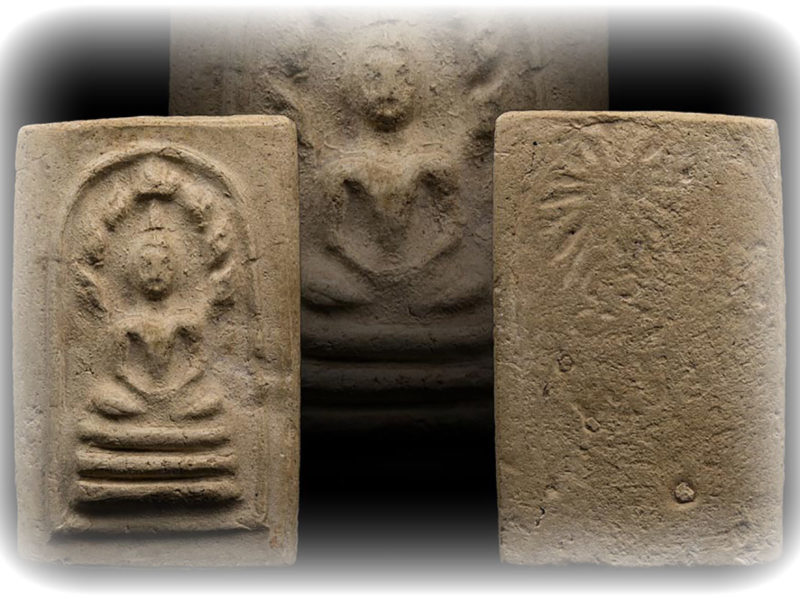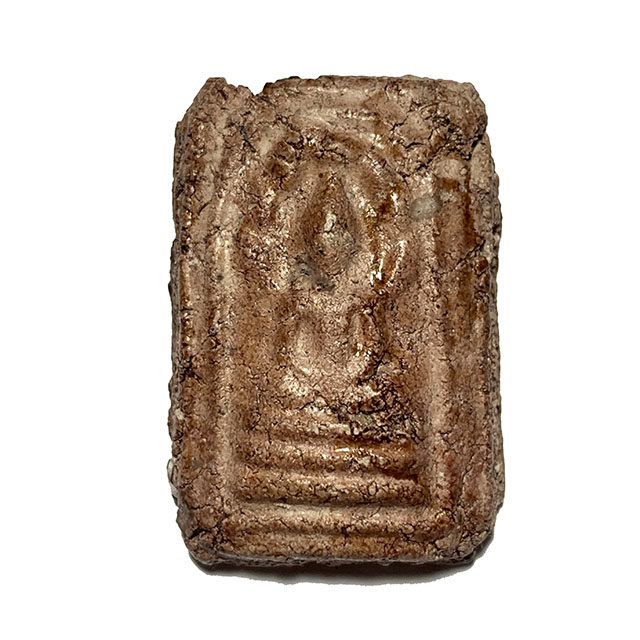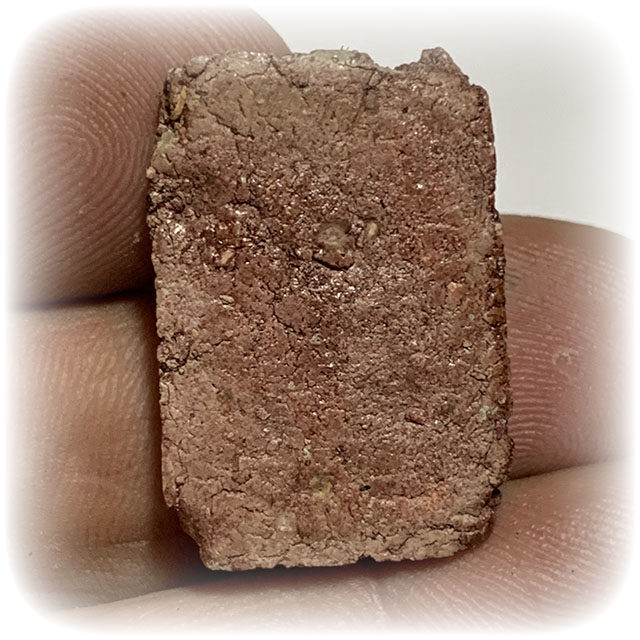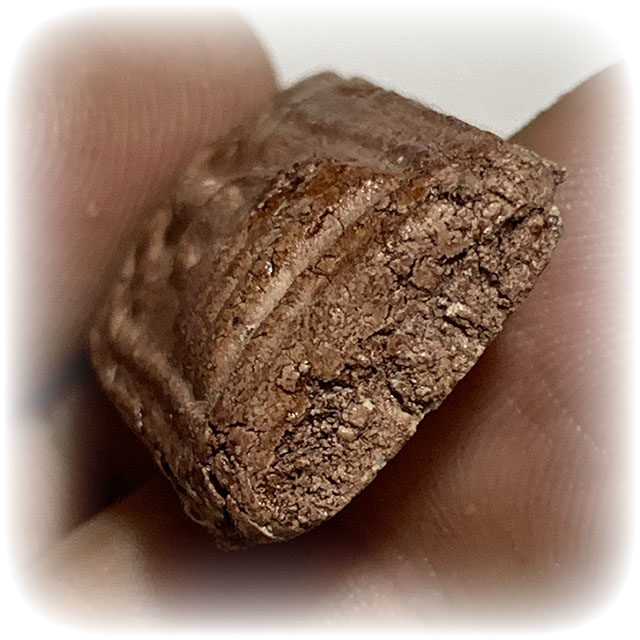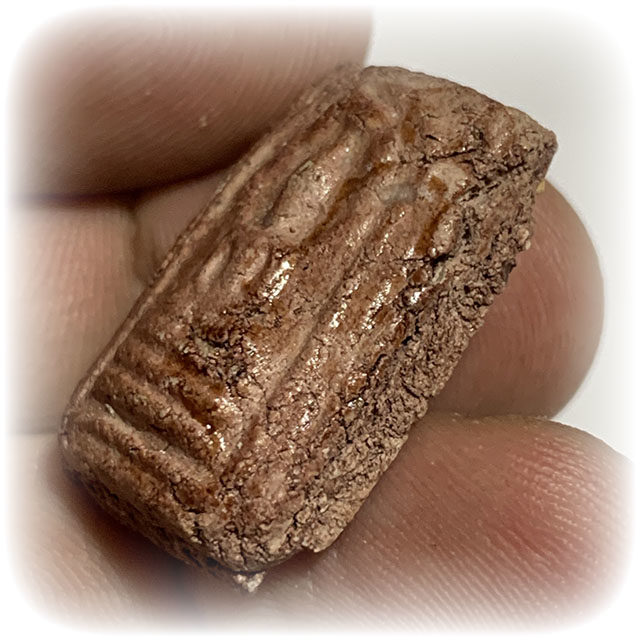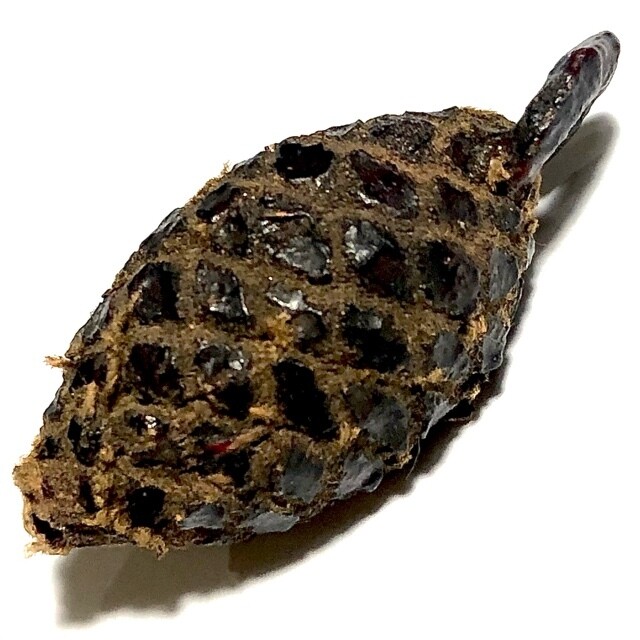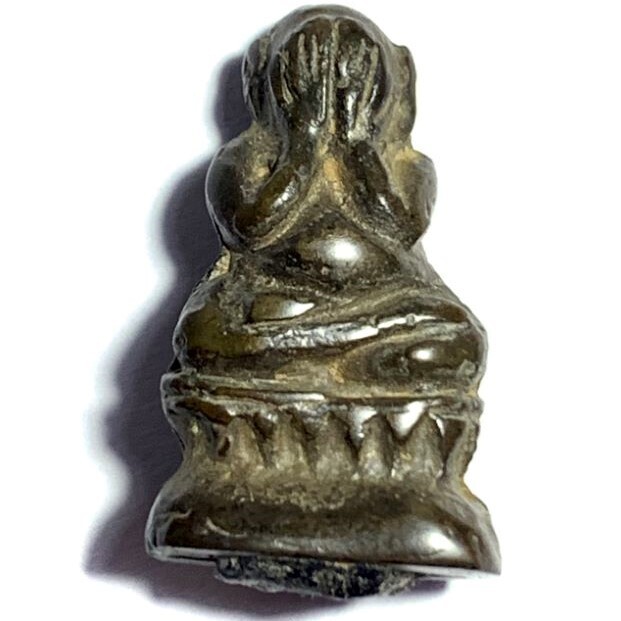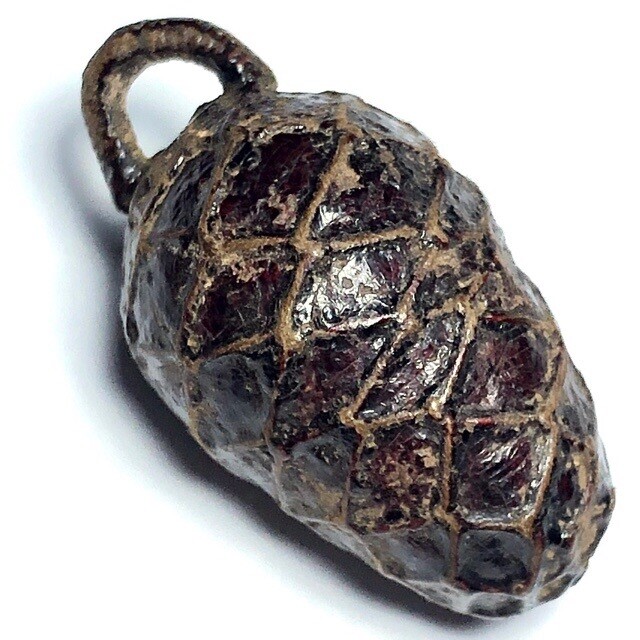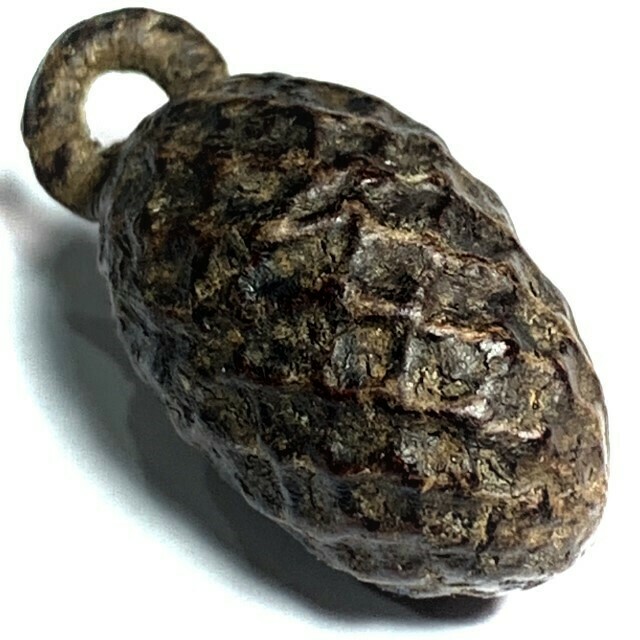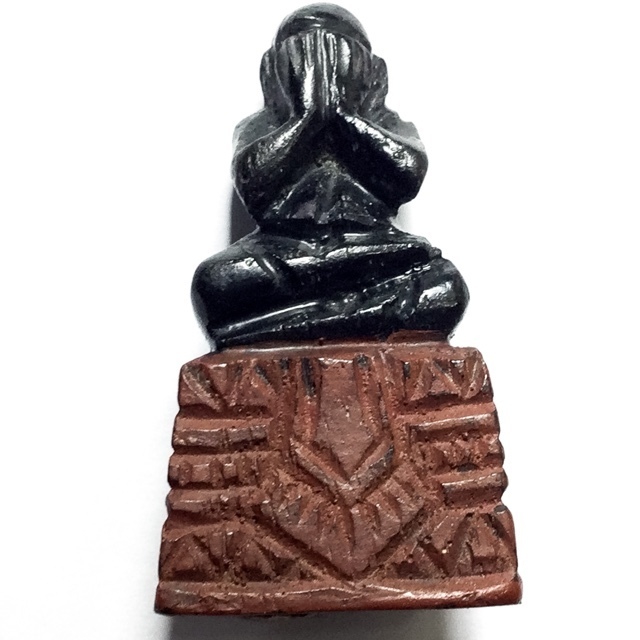The Pra Somdej Mongkol Maha Lap amulet series of 2499 BE, was released at Wat Sarnath, in Rayong, to fund the creation and installment of the Pra Putto Pas Chinarat Jom Muni Buddha statue, which was made at Wat Sapmant Wongs, in Bangkok, and donated to be installed at Wat Sarnath, as the Pra Pratan main Central Buddha image within the Uposatha shrine room.
Below; a rare version of Pra Somdej Nakprok Mongkol Maha Lap Nuea Pong Maha Solos Daeng 2499 BE Mae Chee Bun Ruean Wat Awut
in Nuea Daeng
The amulets were made in various powders, white nuea solos, brown nuea wan, and red nuea wan sabu luead, as well as nuea bailan and other admixtures. Some received the inscription of the Yant Putto, or the Yant Dto Rasamee, of Mae Chee Bun Ruean, and others were left with ‘Hlang Riab’ ‘smooth faced’ rear sides. All versions contain the famous pong Maha Solos Maha Lap (Pong Guubose), which is legendary for its powers
This amulet comes with the existing Stainless Steel Casing – The alternative of Free Waterproof Casing is also an Optional Offer with this Amulet, if you wish to encase with Waterproof Casing at no extra cost. 
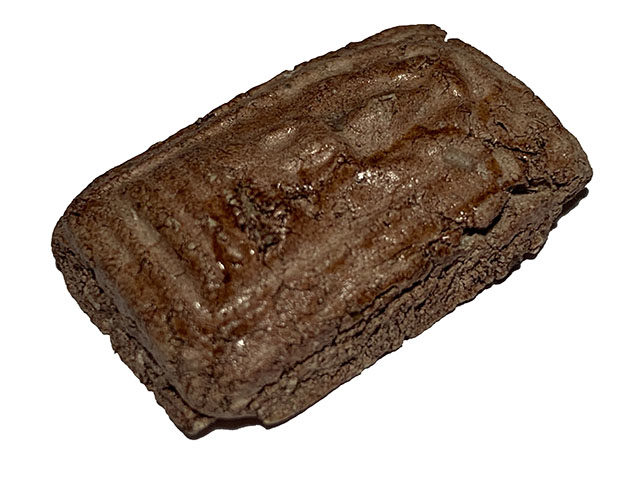
There was never a ceremony to invite the Devas so majestic as the ceremony performed by Mae Chee Bun Ruean, which included not only the ubiquitous incenses, puffed rice, flower garlands in 7 different colors, but also a total of 375 Kinds of Food Offerings! The Benja and 9 Saewadta Chadtras offered, 5 sork high (‘sork’being a Thai form of measurement, meaning ‘5 elbows’, slightly over 2 Feet per ‘sork’). Five Golden and Silver Bai Sri were place in offering, also 5 sork high in stature.
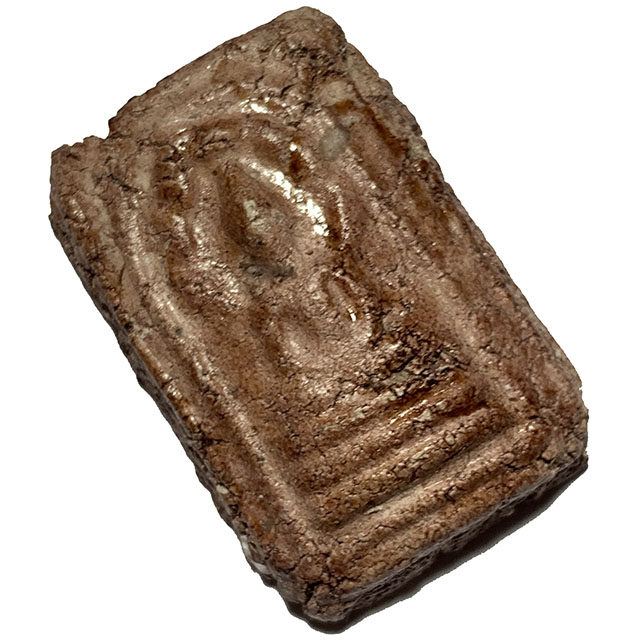
The chanting ceremonyn to bless the holy water with the assistance of the attendiing Devas, was then mixed with the sacred powders used for the muan sarn clays of the amulets. Many great and psychically attained monks were invited to empower and bless the sacred ingredients for the amulets, and the amulets themself after their pressing;
1. Pra Prohm Muni (LP Phin Suwajo), of Wat Bovornives Vora Viharn, 2. Pra Worawaet Kunajarn (LP MIan Bpappasaro), of Wat Pra Chetupon Wimon Manghalaram, 3. Pra Maha Racha Manghalajarn, 4. Pra Kroo Winaiton (LP Fueang Yana Bpaheebpo), 5. Pra Sa-Ard Apiwattano, of Wat Sampant Wongs, 6. Pra Kroo Nor, of Wat Klang Ta Ruea, in Ayuttaya, 7. Pra Ajarn Bung, of Wat Mai Nong Sen, and 8. Pra Luang Por Chorp Sammajaree, of Wat Awut Wigasitaram in Thonburi, as well as the prior and later blessings and empowerments made by Mae Chee Bun Ruean Herself.
In Addition, during the Deva Abhiseka, the Ruesi Yogi Ajarn Rerb (Ajarn Chern Jantr Paetch), who was a very powerful and famous Ruesi of the Era, assisted in empowering the amulets.
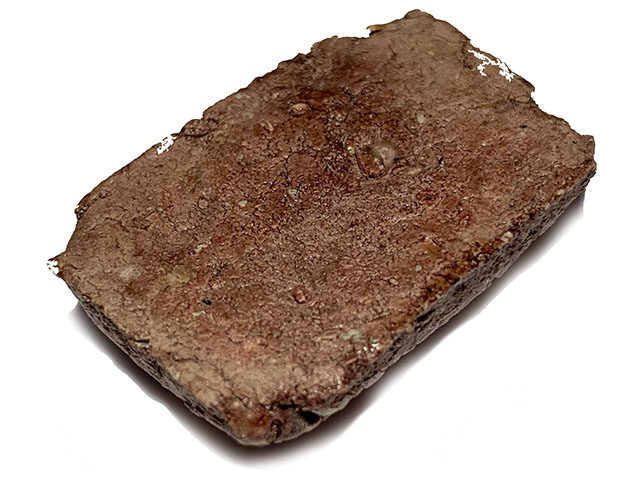
Then a second empowerment session was performed, with the amulets pressed and placed covered with 7 layers of 7 green and 7 white cloths covering them, placed upon an altar in the center of the shrine room.
Many people in the amulet world have been interested in knowing what was used in the making of the sacred powder admixtures, and so we find it impportant to document and list them in this article, for posterity and study;
1. Sacred Powders from a Host of Great Masters of that Era and Previous Eras, through the lineage of each Master who donated and empowered the powders.
2. Powders from Wat Chetupon, Wat Sri Totsataep, Wat Sampant Wongs(Wat Sampantawongs).
3. Broken powdered pieces of ancient sacred amulets.
4. Powdered up herbal ingredients with magical properties, ground up to make a brownish herbal powder.
5. Earths from 7 Prosperous Ports, and the banks of 7 Sacred Lakes. 6. Powders made from taking ancient Kampir Grimoires of Sorcery (Sacred in themself), of both the Bailan Beige Parchmnent variety, and the Samut Khoi black Parchment variety of Grimoire, and burn them and grind into powders, with 5 repetitions of admixture, adding powders from previous editions of amulets.
6. Earths from sacred Pilgrimage Places of the Life of the Buddha in India, brought back to be used for the admixture, to bring Sacred Buddhakhun Power to the amulets, with earths from the important places of the Buddha’s Life, such as the Buddha’s birth, earths from around the Bodhi Tree where the Buddha’s Enlightenment occurred, the place where he gave his first sermon in Varanasi (the Dhamma Chakra), and earths from the place of the Buddha’s Passing into Nibbana.
7. Earths from important places where the Buddha performed great Sermon, or Important Events in his Life occurred, and which are to this day, all sacred places and shrines to the Buddha.
8. Pong Poon Khaw Hin Rachaburi powders.
9. Sacred Talcs invoked with Negative Space inscribed Yantra Spells.
10. Nam Oy Sugarcane Juice.
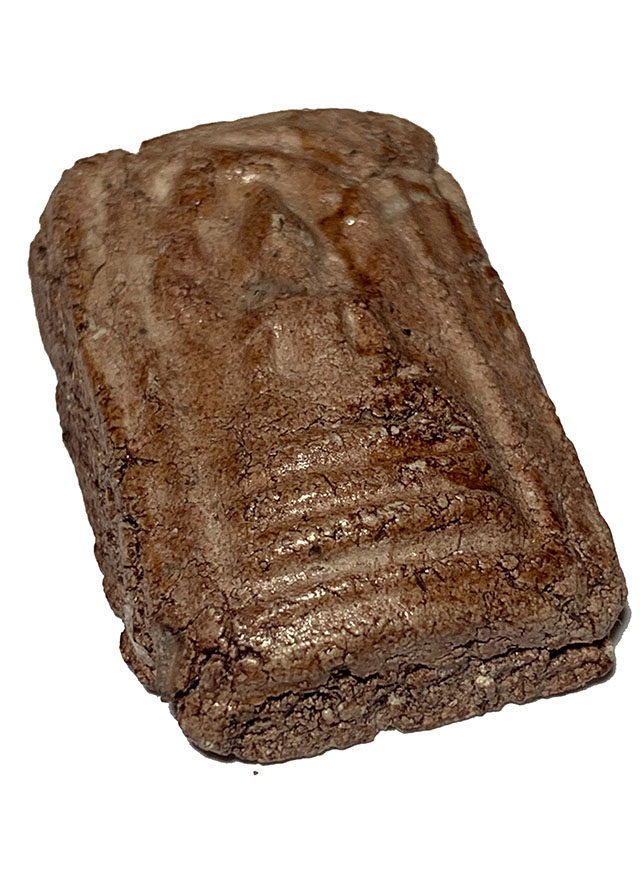
The amulets are made from a Muan Sarn Sacred Powders composed of a large variety of sacred clay earths, herbal pollens and powders, and Puttakun powder. Herbs and Sacred ingredients with all sorts of different blessings and powers were added to give a complete range of blessings.
All these Muan Sarn ingredients were ground into fine powders, and separated into different admixtures, and mixed with holy water from the first Buddha Abhiseka and Deva Abhiseka Blessing Ceremony. The amulets were pressed as the Pra Somdej Pra Putta Mongkol Maha Lap (Buddha Manghala), Pra Nakprok, Pra Putto, and other forms such as various kinds of Pra Somdej, Nang Kwak, and other amulets.
Above and beyond this, the amulet is a Sacred Artifact of Buddhanussati, an authentic Sacred Buddha Image Votive Tablet, blessed and made in 2499 by Kun Mae Chee Bun Ruean, in two ceremonies held at Wat Sampantwongs and Wat Sarnath, both Mae Chee Bun Ruean Lineage Temples.
The amulets were handed out to devotees during a later ceremony who came to donate and support the installation of the Putta Sima temple boundary of Wat Sarnath, and many of the amulets were of course held for burial within shrine rooms and Chedi Stupas of choice, for later distribution, or accidental rediscovery long into the future.
This is a common practice with amulets, where they are placed in a hiding place chamber (Kru), or buried under the ground or under the floor of sacred places, as a way of preserving the fact that there was once a Buddha who walked upon this earth. Hiding Place amulets are also stored in Kru Chambers as a repository to use for fundraising by removing a number and distributing them to devotees who donate to the temple (Note; The placement and removal of amulets from Kru for providing a method of creating fundraisers only became a practice during the last century, after Buddhist amulets became a source of fundraising).
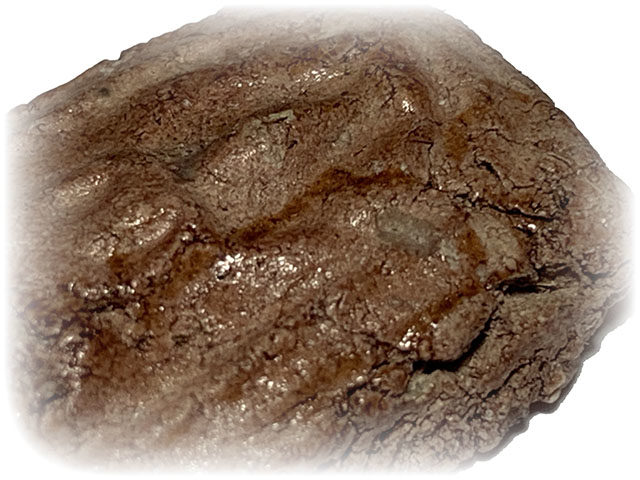
According to the written documentation of Luang Phu Tet Nitesago, the Pong Solos powders made by Mae Chee Bun Ruean to make the amulets, were made using the Wicha Prohmasat (Brahma Sastra), which invokes High Brahmas and Ariya Sangha (Enlughtened Beings), of the Sutawas celestial level, to empower the powders. They were made to distribute to devotees, and fund the installation of the Pra Putto Chinarach Jom Muni Buddha statue of Wat Sarnath.
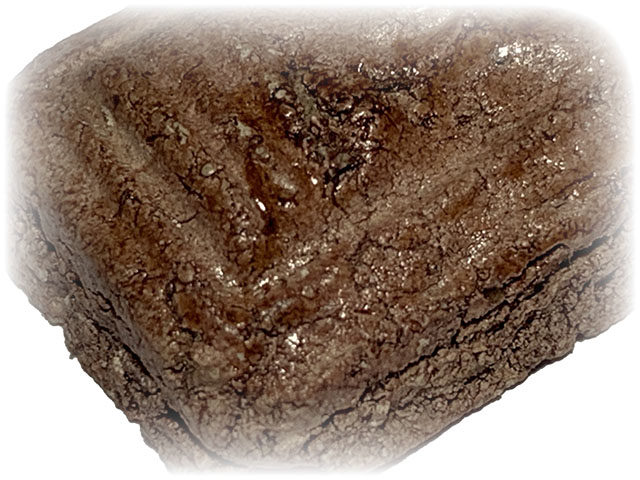
The amulets have become very famed for their miraculous powers, due to many stories of miraculous events connected with devotees and the amulets. Mae Chee Bun Ruean invoked the spiritual Connections of the angelic beings of the Buddhist, Christian and Islamic Faiths to imbue their blessings, to protect people of all religions, who keep the precepts of goodness and abstention from evil acts. The real name of the powders is ‘Pong Maha Prohm Ariya Bodhisattva Phuu Bpen Jao’ (Powders of the Enlightened Brahmas who are Lords of their Existence’).
This was because of Ajarn Seng, who taught and revealed that all three religions, speak of the same one Super-consciousness or ‘God’ (Buddha-hood for Buddhists), but which different cultures over time split and adapted into their own social structures, and changed them according to their needs, but that all three are derived from the same fact that enlightened beings gave teachings to unenlightened humans, and were worshiped for it as messiahs, prophets, or gods, and became founders of these religions.
The great Luang Por Lee is said to have found the 2499 BE Somdej Mongkol Maha Lap so powerful that he basked for some of the broken ones to be given to him to mix into the sacred clay of his famous sacred Pra Bai Po Jak amulets of the 2500 BE 25 Centuries of Buddhism Mega Nationwide Amulet Ceremony.
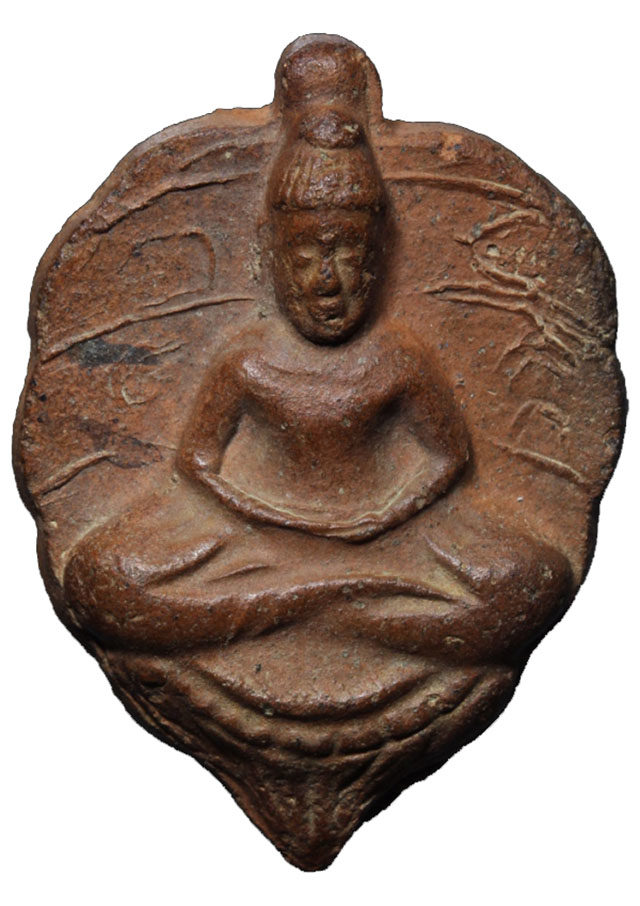
Pra Bai Po Jakr LP Lee Wat Asokaram
According to the Pra Tamma Khant, all Somdej amulets must be made in numbers of 84,000, but it is rumored that the Pra Putta Mongkol maha lap amulets were made in much less numbers, which is an unconfirmed rumor, and would be dubious considering Mae Chee Bun Ruean’s tendency to be a stickler for proper ritual and adhere to the dtamrta of the Wicha.
The Pra Putta Mongkol Maha Lap amulet is often used as a substitute for the Pra Pong Solos of Luang Phu Tim (much more difficult to find and much more expensive). Luang Phu Tim himself was also invited to perform Nang Prok meditative empowerment on thje amulets, as he was 70 years old. Considered one of the best amulets of the 2500 BE Era of Thai Buddhist Amulets.
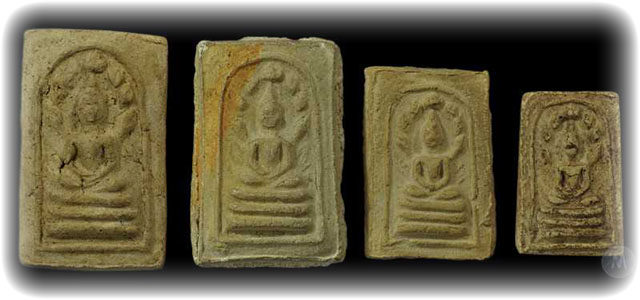
Pra Somdej Putta Mongkol Maha Lap various sizes in white Pong Solos Powders.
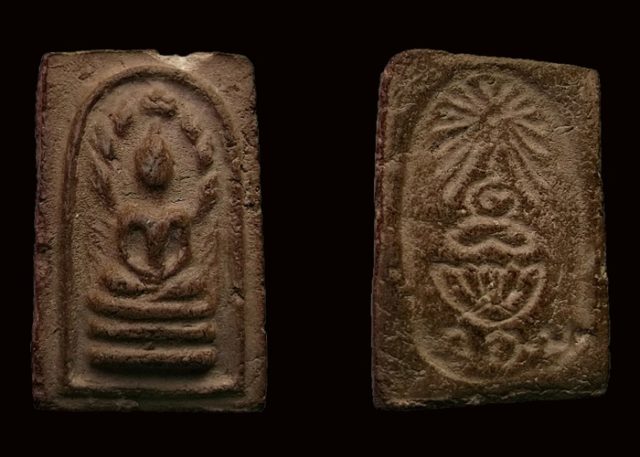
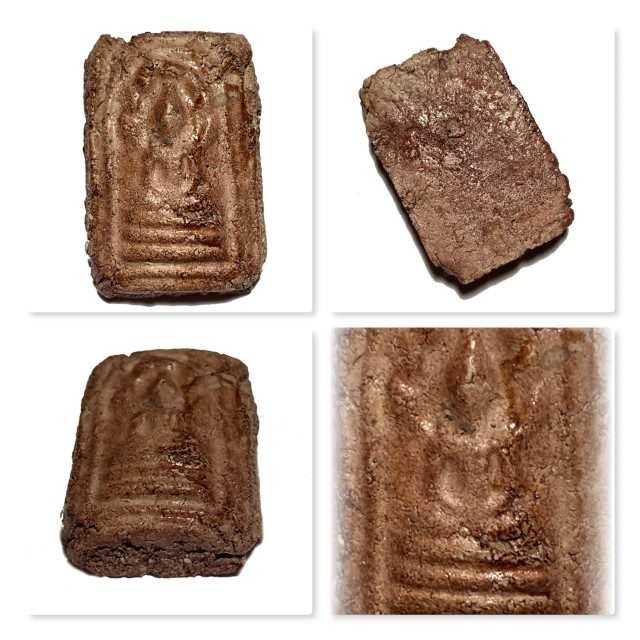
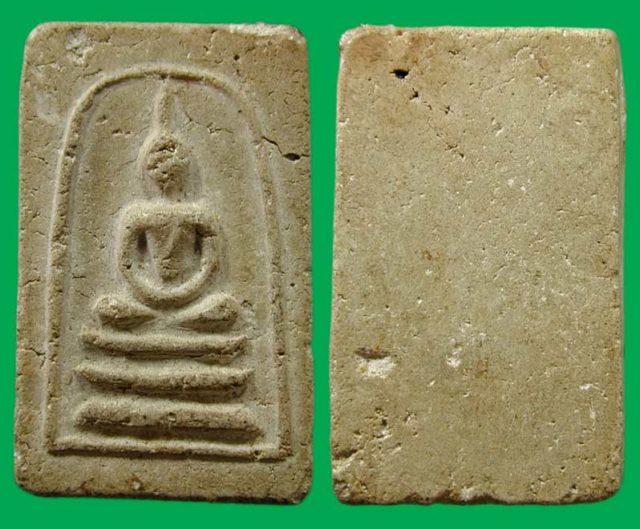
Another version of the Pra Somdej Putta Mongkol Maha Lap Nuea Solos
Luang Phu Iam (Wat Hnang)
Luang Phu Iam was a World Famous Master Monk of the previous Century, and maker of the Number 2 Amulet of the Top 5 'Benjapakee' of Pra Pid Ta of all Thai Buddhist History, the Pra Pid Ta Yant Yung. Luang Phu Iam is the No.2 Master of all History, renowned for Pra Pid Ta Amulets, and his Rare and Powerful First Edition Monk Coin, which fetches extremely high prices in auctions.
Pra Pāwanā Gosol Thēra (Luang Phu Iam Suwannasarõ)
Luang Phu Iam was a born on Friday the 7th October 2375 BE. Luang Phu Iam was born a Citizen of Bang Khun Tian, whose household lived on the banks of the Klong Bang Hwa Canal, behind the temple of Wat Hnang. Luang Phu Iam was born during the reign of His Majesty Prabat Somdej Pra Nang Glao Jao Yuu Hua King Rama 3. Luang Phu Iam was given the birthname of ‘Iam’ and his surname was ‘Tong U’. The devotees of Wat Hnang temple did not call him Luang Phu Iam, rather, preferred to call him ‘Luang Por Phu Tao’.
People in General, and the collectors of the amulet appreciation societies like to refer to Luang Phu Iam as ‘Luang Por Wat Hnang’. His father and mother’s names were Mr. Tong, and Mrs. U, with the surname ‘Tong U’. Luang Phu Iam’s family were market gardners, and were relatively prosperous. At the age of 9 years old, Luang Phu Iam was taken to the temple of Wat Hnang, to learn to read and write, and practice Khom Agkhara, under the tutelage of his first mentor, Luang Phu Rod, then Vice Abbot of Wat Hnang.
In the year 2387 BE, Luang Phu Rod then began to teach him Wicha Akom Buddha Magic and also to teach him in the Pali Sanskrit scripts, and the Khom Agkhara used for Magical Inscriptions. At the age of 11, in the year 2386 BE, Luang Phu Iam also went to study Pali Sanskrit with Pra Maha Yim at Wat Bovornives Voraviharn.
After he finished his studies with Pra Maha Yim, Luang Phu Rod then went to practice under the tutelage of Pra Pidok Gosol (Luang Por Chim), at Wat Liab.
Thereafter, he returned to Wat Hnang, and ordained as a Samanera Novice Monk, and studied the Dhamma in his original place of learning at Wat Hnang. Luang Phu spent many years focused on study and practice, for about one decade, until the year 2394 BE.
Luang Phu was now coming of age where he should ordain from Samanera to become full status of an adult Bhikkhu, and had to go to the Royal Sanam Luang to take his Pali Sanskrit exams, which were at that time, done orally, answering in front of the teacher without any written questions to answer. Luang Phu did not pass the test. Because of failing his Pali exam, Luang Phu decided to disrobe and go to help his parents and relatives at home.
But Luang Phu only managed to remain a layman for three years, and his true calling became evident, and Luang Phu returned in the year 2397 BE to Re-Ordain as a Bhikkhu in the Buddha Sasanā at Wat Jom Tong, at the age of 22 years old.
Luang Por Gerd was his Upachaya Ordaining Officer, and gave Luang Phu Iam the Ordained Name of ‘Suwannasaro’
His Pra Gammawājājārn was Pra Tamma Chedi (Luang Por Jeen), with Pra Pawanā Gosol Thēra (Luang Phu Rod) as his Prompting Officer.
Once he had Re-Ordained again, Luang Phu Tao (Luang Phu Iam) went to stay at Wat Nang Nong, which was across the other side of the path to Wat Nang Nong. Here he continued his written studies of the Dhamma and Sorcery Grimoires, and Mastery of various Wicha, in the Samnak of Luang Por Jeen, with supplementary tuition from Pra Sangworn Wimol (Luang Por Hmen).
This time Luang Phu Iam went to finish his exams once more at Sanam Luang, and passed with flying colours. The ordained professor of Pali who was examining him, then said he had given very good translations, and invited Luang Phu Iam to come and practice at the same Samnak.
Luang Phu Iam however, refused, and continued with his usual trajectory. He then focused deeper on his practice of Vipassana Mindfulness Practice, and Puttakom (Buddha Magic) with Luang Phu Rod (who was abbot of Wat Nang Nong).
It can be seen from historical documentation, that Luang Phu Iam followed the footsteps of of Luang Phu Rod, in the same way that Somdej Pra Puttajarn (Dto) Prohmrangsri of Wat Rakang Kositaram had followed in the footsteps of his Mentor Pra Sangkarach (Sukh Gai Thuean). Luang Phu Iam hence mastered the various Wicha of Luang Phu Rod, with his diligence and unquestioning service to Luang Phu Rod as his Mentor.
Sometime around 2440, Luang Phu Rod had his Royal Pat Yos fan confiscated and was stipped of Royal status, and moved from Wat Nang Nong to gp stay at Wat Ko Non. This was because Luang Phu Rod refused to use the official terminology of respect towards King Rama 4, because he was angry about the splitting of the Sangha into Dhammayut, and Maha Nikaya sects, which he considered the King to have caused a schism in the Sangha. Luang Phu Iam and his devotees followed Luang Phu Rod to Wat Ko Non, and Luang Phu Iam continued to practice and continue to practice his Wicha with Luang Phu Rod, for many years.
This comparison is also extendible to the amulets of both Masters, just as Somdej Pra Puttajarn (Dto) Prohmrangsri learned the Wicha Pra Somdej from Somdej pra Sangkarach Sukh (maker of the Pra Somdej Arahang Benjapakee Amulet), so, in turn, did Luang Phu Iam make powerful Pra Pid Ta and Pra Pid Tawarn amulets, in the same Dtamra (formula) of his Mentor Luang Phu Rod.
The third Comparison between the two Monks, reveals that both Somdej Pra Puttajarn (Dto) Prohmrangsri and Luang Phu Iam managed to attain the same fame and reverence as their Mentors, and their amulets became equally reputed for their magical power.
Luang Phu Iam created the same style of imagery as Luang Phu Rod for both kinds of Pid Ta amulets, and his Wicha is so equal in power to that of Luang Phu Rod, that one will often seen devotees collecting the amulets of both masters with equal fervency. It is not uncommon to see a high-end collector wearing a Pra Pid Ta Luang Phu Iam alongside a Pra Pid Ta Luang Phu Rod on the same necklaceใ
Some time after the passing of his Mentor Luang Phu Rod, in the year 2441 BE, Luang Phu Iam was called upon by his Majesty King Prabat Somdej Pra Julajom Glao Jao Yu Hua (Rama 5), to become the abbot of Wat Hnang, and perform the duty of its maintenance and further development.
Luang Phu Iam proved to be a Great Abbot, and diligently restored and developed the temple and its facilities. Luang Phu Iam was a highly favoured Monk of His Majesty King Rama 5, and was more often than not always requested to attend the most important Blessing Ceremonies, and Buddhist Rituals of the Royal Palace. His name 'Pra Pawana Gosol' was bestowed upon him by his Majesty the King, at the time he was given the charge of Wat Hnang temple.
Luang Phu Iam then spent 27 Years working selflessly for the temple and devotees of Wat Hnang, for another 27 years, until his passing on the 26th April 2469 BE, at the age of 94. His Pid Ta Yant Yung metallic amulet is equally highly regarded for its Klaew Klaad Kong Grapan Chadtri Maha Ud power, as the famous Pra Pid Ta Rae Bang Phai, and the Pra Pid Ta Wat Tong, and the Pra Pid Ta Pim Tapap of Wat Sapan Sung.
